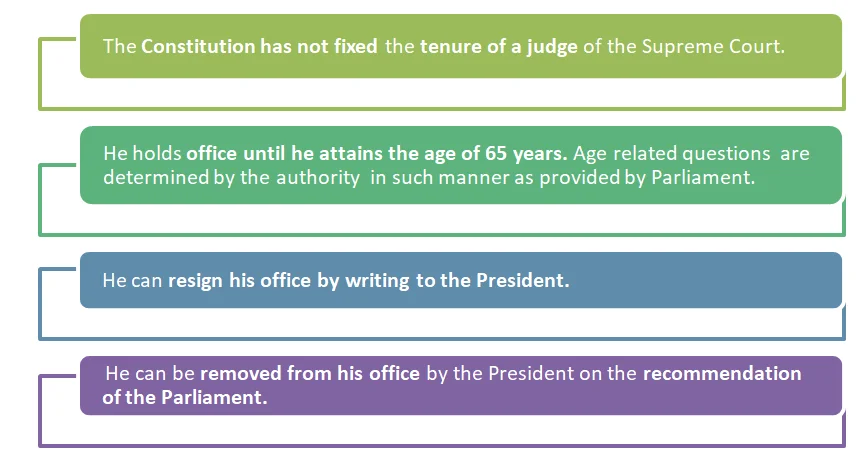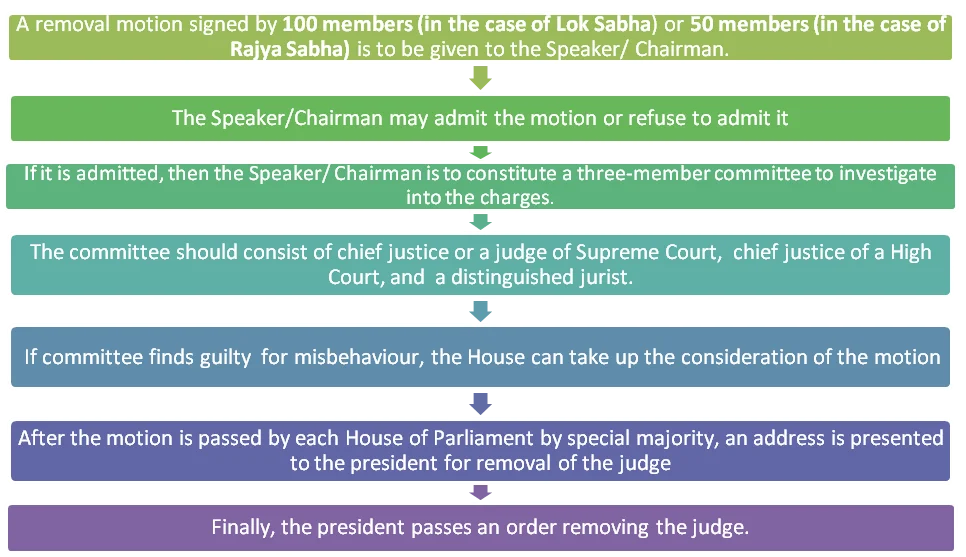The Supreme Court of India holds a pivotal role as the highest court of appeal, guardian of the Constitution, and protector of citizens’ fundamental rights. This article delves into the tenure, removal, acting, ad-hoc, and retired judges, as well as the procedures and independence of the Supreme Court. By ensuring impartiality and safeguarding against executive and legislative pressures, the Supreme Court maintains its integrity and authority.
Supreme Court of India
Tenure and Removal
Tenure of Judges

Enroll now for UPSC Online Course
Removal of Judges (Article 124 (4) & (5))
- Order by the President: The Judge of the Supreme Court can be removed from his Office by an order of the President. The President Issues the removal order only after an address by Parliament has been presented to him in the same session for such removal.
- Support by Special Majority: This address must be supported by a special majority of each House of Parliament.
- A majority of the total membership of that House and
- A majority of not less than two-thirds of the members of that House present and voting.
- Regulation of Judge Removal Procedure: The Judges Enquiry Act (1968) regulates the procedure relating to the removal of a judge of the Supreme Court by the process of impeachment:

- Initiation of Impeachment: The process for the removal of a judge begins with the initiation of removal motion.
- Notice of Motion: A notice of motion for the removal of a judge is required to be presented in either house of Parliament—Lok Sabha (House of the People) or Rajya Sabha (Council of States).
- Signatories: The notice of motion must be signed by either 100 members of Lok Sabha or 50 members of Rajya Sabha.
- Constitution of Investigative Committee:
- After the notice is submitted, the Chairman of Rajya Sabha or the Speaker of Lok Sabha can either admit the notice or reject it.
-
-
- Once admitted, the Chairman or the Speaker constitutes a three-member committee to investigate the charges against the judge.
- The committee typically consists of the –
- Chief Justice of India or a judge of the Supreme Court,
-
-
- A Chief Justice of a High Court, and
- A distinguished jurist.
- Investigation and Report:
-
-
-
- The committee conducts a thorough investigation into the charges presented in the notice of motion.
- The committee submits its findings and a report to the Speaker of Lok Sabha or the Chairman of Rajya Sabha, depending on the house where the motion was initiated.
-
-
- Parliamentary Approval:
-
-
-
- The motion for removal is then taken up for consideration in the house where it was initiated.
- For the motion to be successful, it must be supported by a special majority, which means a majority of the total membership of that house and a majority of at least two-thirds of the members present and voting.
-
-
- President’s Approval:
-
-
-
- If the motion is passed by the house, it is presented to the President for approval.
-
-
- The President’s assent is required for the removal to take effect.
- Safeguard for Judicial Independence: It’s crucial to note that the removal process is a safeguard to ensure judicial independence and protect judges from arbitrary removal.
- The process involves a thorough investigation and requires significant political consensus to prevent misuse of the removal mechanism.
Note: The first case of impeachment is that of Justice V. Ramaswami of the Supreme Court (1991–1993) but he could not be removed as the Congress Party abstained from voting.

ACTING, AD-HOC AND RETIRED JUDGES
Appointment of Acting Chief Justice (Article 126)
- Appointment by the President: The President appoints a judge of the Supreme Court as an acting Chief Justice of India when
- Vacancy of Chief Justice’s Office: The office of Chief Justice of India is vacant or
- Inability of Chief Justice to Perform Duties: When the Chief Justice is, by reason of absence or otherwise, unable to perform the duties of his office,
Note: India’s 50th Chief Justice DY Chandrachud is among the 50 Chief Justices that the country has had since its Independence
Appointment of Ad hoc Judge (Article 127)
- Appointment by Chief Justice of India: If there is a lack of quorum in the Supreme Court for permanent judges to hold or continue any session, then the Chief Justice of India can appoint a judge of a High Court as an ad hoc judge of the Supreme Court for a temporary period.
- Consultation and Consent: He does this only after consultation with the Chief Justice of the High Court concerned and with the previous consent of the President.
- Qualification: The judge so appointed should be qualified for appointment as a judge of the Supreme Court.
- Duties and Power:
- It is the duty of the judge so appointed to attend the sittings of the Supreme Court, in priority to other duties of his office.
- While attending as an Ad hoc Judge he enjoys all the jurisdiction, powers and privileges of a judge of the Supreme Court.
Attendance of Retired Judge (Article 128)
- Request for Acting Judge: The Chief Justice of India (CJI) can request a retired judge of the Supreme Court or a retired judge of a High Court to act as a judge of the Supreme Court for a temporary period, who is duly qualified for appointment as a judge of the Supreme Court.
- Such a judge is entitled to such allowances as the President may determine.
- Procedure: The CJI can do so only with the prior consent of the President and also of the person who is to be so appointed.
- Powers and Privileges: He will also enjoy all the jurisdiction, powers and privileges of a judge of the Supreme Court.
Seat and Procedure of Supreme Court
Seat of Supreme Court (Article 130)
- Location of the Supreme Court: As per Article 130, Delhi is the location of the Supreme Court, but the Chief Justice of India can also choose other places as its seat.
- Presidential Approval: However, he or she needs the prior approval of the President for this. This is an optional provision and not a mandatory one.
Procedure of the Court
- Rule-Making Authority: The Supreme Court can make rules for regulating practice and procedure of the Court with the approval of the President.
- Constitutional Cases: The Constitutional cases or references made by the President under Article 143 are decided by a Bench consisting of at least five judges.
- Decision-Making in Other Cases: Rest of other cases are decided by single judges and division benches by majority vote but if differing, then judges can give dissenting judgements.
Independence of Supreme Court
- Role in the Indian Political System: The Supreme Court has a very significant role in the Indian democratic political system due to its nature of the highest court of appeal, the guarantor of the fundamental rights of the citizens and guardian of the Constitution.
- Independence from External Influence: It is free from the encroachments, pressures and interferences of the executive and the Legislature.
- It has been allowed to do justice without fear or favour.
- Constitutional Safeguards: The Constitution has made the following provisions to safeguard and ensure the independent and impartial functioning of the Supreme Court:
| Mode of Appointment |
|
| Security of Tenure |
|
| Fixed Service Conditions |
|
| Expenses Charged on Consolidated Fund |
|
| Conduct of Judges cannot be Discussed
|
|
| Ban on Practice after Retirement |
|
| Power to Punish for its Contempt |
|
| Freedom to Appoint its Staff |
|
| Its Jurisdiction cannot be Curtailed |
|
| Separation from Executive |
|
Enroll now for UPSC Online Course
| Must Read | |
| Current Affairs | Editorial Analysis |
| Upsc Notes | Upsc Blogs |
| NCERT Notes | Free Main Answer Writing |
Conclusion
In summary, the Supreme Court’s structured procedures for tenure, removal, and appointment of judges, alongside the provisions ensuring its independence, fortify its position as a cornerstone of India’s democratic framework.
- The careful balance of privileges, protections, and procedural rules enables the Court to function without bias, upholding justice and constitutional values in the nation.
Sign up for the PWOnlyIAS Online Course by Physics Wallah and start your journey to IAS success today!
| Related Articles | |
| Who is the First Woman Chief Justice of India? | Houses of Parliament |
| Supreme Court | Fundamental Rights |

 GS Foundation
GS Foundation Optional Course
Optional Course Combo Courses
Combo Courses Degree Program
Degree Program











